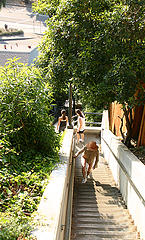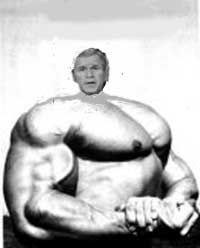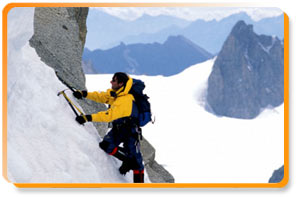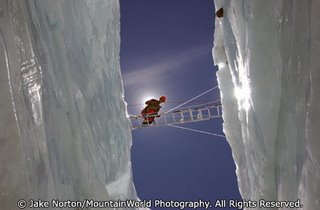I have no quads. I mean, I physically have quads - I suppose it would be tough to have a complete set of legs without having quadriceps in there somewhere - it's just that my quads are so gosh darn weak they might as well not be there in the first place.
(Side Note: The word Quadriceps sounds like one heck of a mean dinosaur doesn't it? I never realized that. All of the sudden I feel like I'm in Jurassic Park. Watch out, Johnny! The Quadriceps are going to eat your face!)
What with this weak quad situation, you can imagine the difficulty I have in climbing the Santa Monica steps. Have I told you about the Santa Monica steps? I don't think I have. Maybe we should start there...
The Santa Monica steps are, as you can probably imagine, a set of steps. In Santa Monica. There are about 189 of these so-called steps, give or take none. In the mornings and early evenings you will find a steady flow of people all quietly aligned in single file, hugging the right side of the wall and attentively climbing up and down this unrelentingly steep staircase. The thing is, probably less than 5 of them are actually using the stairs to get somewhere. No, no, these aren't really considered functional stairs that will get you, say, from point A to point B. They are not commuter stairs; they don't lead you anywhere important that you can't get to via a much easier route. They are more the walk-up-and-down type of exercise stairs that pretty much get you from Point A back to Point A. And they do it as painfully as possible.
Sounds silly, doesn't it, these meaningless stair walking shenanigans? I agree. Of course, that doesn't mean I don't participate in the activity. Yes, I am sometimes one of those silly stair walking people, carefully winding my way down the steep concrete descent only to turn around at the bottom for the leg-burning, lung busting climb back up. And once I get to the top, huffing and puffing and coughing out lungs I no longer have, I lift up my eyes to look around and realize that I am in the same exact place from whence I started.
So silly.
Anyway, this morning was one of those stair climbing mornings for me. There's not a lot to think about while you are climbing the stairs. Your eyes are solidly set on your feet to make sure you don't take a sudden misstep, fall and require an emergency trip to the face repair doctor. Consequently, you don't really make much eye-to-eye contact with the people heading in the opposite direction. It's more like eye-to-toe contact. If you've got a foot fetish, this might be your heaven.
There's not a lot to think about while you are climbing the stairs. Your eyes are solidly set on your feet to make sure you don't take a sudden misstep, fall and require an emergency trip to the face repair doctor. Consequently, you don't really make much eye-to-eye contact with the people heading in the opposite direction. It's more like eye-to-toe contact. If you've got a foot fetish, this might be your heaven.
However, what with all of the pain you are experiencing during the climb, it helps to keep your mind occupied on other non-essential matters than the passers-by's feet. This morning, for instance, I was thinking about the show Everest.
(Wait a minute, did I just say "passers-by's feet"?!)
Have you seen Everest? It's an amazing 6-episode show on the Discovery Channel. Actually, the sixth and final episode aired this week, so its over. You lose. Actually, I recommend you TiVo it (I believe they are replaying all episodes over the next week or two) or, better yet, don't be such a cheapskate and get the DVD when it comes out. It is a highly addictive, brilliant insight into what happens on the horrendously difficult climb up the world's tallest mountain.
The show follows a group of climbers in 2005 (the second most deadly year on the mountain, for the record) and documents all the physical and emotional crap they go through. Little did they know when they set out on this expedition that there would be quite a buttload of physical and emotional crap occurring on the mountain that year, not to mention the controversial actions that involve such intriguing cocktail party chatter as climbers freezing to death. So as I was saying, while I was climbing up these stairs with my legs all a-burning, I started thinking about what these alpiners had to go through to get up Everest. I mean, they've got the fear of death hanging over their heads pretty constantly. They've got enormous strain on their body with even the slightest move. And don't even get me started on the destruction of rational thinking and trying to live on extremely little oxygen. It's crazy stuff for crazy people.
So as I was saying, while I was climbing up these stairs with my legs all a-burning, I started thinking about what these alpiners had to go through to get up Everest. I mean, they've got the fear of death hanging over their heads pretty constantly. They've got enormous strain on their body with even the slightest move. And don't even get me started on the destruction of rational thinking and trying to live on extremely little oxygen. It's crazy stuff for crazy people.
And so that got me to thinking about how people called Catherine and I crazy for wanting to do an Ironman. Us crazy?! Bitch pleeeease! Naturally, I started wondering who is more fit: Ironman athletes or Everest climbers.
I put a full 378 steps of thought into this one and here's what I came up with...
First, I think we need to split "fitness" into two different categories: physical and mental. As we know, both activities, Ironman racing and Everest climbing, rely on a combination of physical and mental strength.
The Physical The average Ironman athlete trains for about eight months prior to their big race. That is eight months of solid, virtually non-stop daily training. Ironman racing creates some pretty heavy pounding on the body. Physical fitness is the barrier to entry. By the time we triathletes hit that starting line, we're pretty damn physically fit. One can say that we're most likely the fittest we've ever been in our lives.
The average Ironman athlete trains for about eight months prior to their big race. That is eight months of solid, virtually non-stop daily training. Ironman racing creates some pretty heavy pounding on the body. Physical fitness is the barrier to entry. By the time we triathletes hit that starting line, we're pretty damn physically fit. One can say that we're most likely the fittest we've ever been in our lives.
Alpinists, on the other hand, train for about two years in preparation for climbing Everest. When I first started pondering this I thought, Holy shit, two years?! They must be in wicked good shape. However, I then realized that this two years of alpine training isn't necessarily all focused on the physical. It's not like Ironman training where it's non-stop physical activity. The Everest climbers aren't out there lifting weights and going on hikes every day of the week for two years. Sure, they're training their bodies to walk the distance, but a lot of the training is preparing their bodies for high altitude activity and learning to walk with 50 pounds on your back.
Ironman training where it's non-stop physical activity. The Everest climbers aren't out there lifting weights and going on hikes every day of the week for two years. Sure, they're training their bodies to walk the distance, but a lot of the training is preparing their bodies for high altitude activity and learning to walk with 50 pounds on your back.
I'm not saying Everest climbers are fat, I'm just saying that when it comes right down to it, Ironman racers are better conditioned. Sooo, on the physical front I'm going to have to give the award to Ironman athletes.
Ironman: 1
Everest: O
The Mental
As many of us know (and many others assume), mental training is a key ingredient in completing an Ironman. Ironman racing is tough. Actually, the last 10-15 miles of Ironman racing is tough. If you don't have the mental strength (on top of the physical fitness we've already established above), you're not going to make it. To paraphrase an Adidas ad from many moons ago, It's exercise for the first 15 miles, after that it's just some sort of sick compulsion fueled by God knows what.
All that said, the mental training required for Ironman racing is but an unpopped kernel in the super-sized bucket of mental popcorn required for successfully climbing Everest. There is so little oxygen up there at the top of the world, the body literally eats itself to survive. It's not pretty. Every step, every thought and every miniscule movement is a struggle when you're up there on the top of the world.
Picture it this way. On your worst day at the world's toughest Ironman, it may take you 30 minutes to stumble through one mile. While on Everest, on the best day, with optimum conditions of 20 below zero, it takes the most proficient climber about two hours to complete one mile. Two hours!?!!!
While on Everest, on the best day, with optimum conditions of 20 below zero, it takes the most proficient climber about two hours to complete one mile. Two hours!?!!!
Imagine that. Imagine what excruciating pain you must go through, what patience and will-power you must have, for it to take two hours to hike one mile. Yeah, Ironman is tough. But it ain't no Everest.
In Ironman, if you get tired or hurt, you walk, you lay down or you stop. Get hurt in Everest? You've got two options: somehow, someway carry your sorry ass down the mountain through the painful 18 hour day.... or die. And dying isn't a good option. It's pretty simple.
So when it comes to mental capacity, I'd have to say the Everest climbers smoke us. We're crazy. They're crazier.
Ironman: 1
Everest: 1
So who is more fit? I don't know.... you tell me.
December 22, 2006
Ironman Mount Everest
Posted by
j.
at
9:32 AM
![]()
![]()
Subscribe to:
Post Comments (Atom)

4 comments:
No offense to all of you Ironmen out there, I'd have to go with the Everest climbers. I think given the extreme conditions under which they're hiking, their physical capacity may come closer to IM than the IM comes to the mental challenge of Everest. They've got the more complete package going. The tragic swim death at IMFL notwithstanding, it's not really life or death out there for IM athletes. I hope to catch that on TV, though.
This answer is close to home. I've been told that the major difference between an Ironman and Mt. Everest is not endurance related- it's the mental focus. Climbing demands your complete focus at every minute while the distance of IM gives your mind plenty of time to be all over the place.
I've been captivated by that show as well. The Ironmen (and women) are definitely in better physical condition for athletic performance, but the climbers are better conditioned for survival and overcoming adversity.
The show has made me definitely NOT want to get anywhere near Everest.
I was just browsing through the net searching for a new HITT routine for my climbing and stumbled on this. First off, I do agree with you on strengths that both ironman athletes have as well as mountaineers. However, one thing to consider here is that the two sports are not mutually exclusive. Many of the most successful mountaineers on everest train by ultramathons or ultracycling so the conditioning may not be as different as you would think. However one reason many climbers do not focus as much on this type of fitness is that climbing, especially at altitude is like trying to solve a puzzle when your drunk. Much of the training goes into skills development and decision making. The reason for the difference in the mental aspect is probably the fact that most climbers worth their weight respect the notion that no matter how in shape you are, if you make poor decisions you will fail or die. If you are physically fit it only means that one of your bases are covered, there's a lot that can go wrong.
Post a Comment